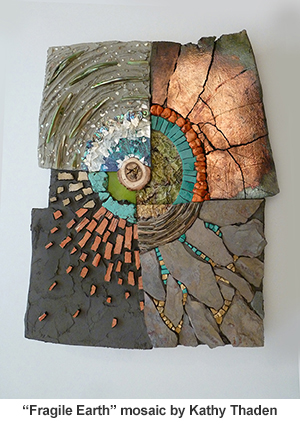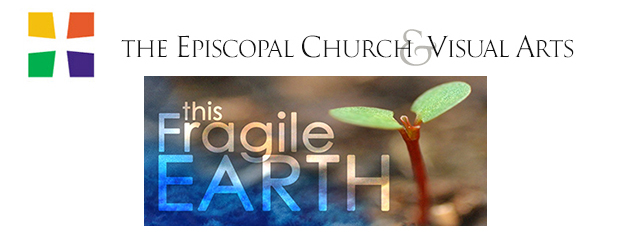| Curator's Statement |

The variety of works submitted for the 2018 ECVA Fall Exhibition "This Fragile Earth" is a wonderful reminder of the richness and varied talents of ECVA member artists. It was inspiring for me to look through the entries and I pray that as you view the exhibition, you too, will be equally inspired. My heartfelt gratitude goes to all who submitted works for consideration, for the gifts of creativity and spirituality that bless each of us. I invite you to share in this exhibit, savoring each artist’s insights to the theme, "This Fragile Earth." 
Moving beyond the pure beauty of the Earth, ECVA artists were also encouraged to consider the effects of changing weather and climate not only on the planet, but on our sisters and brothers globally. Shin-hee Chin speaks to this in her quilt "Eyes Wide Open: Seeing Light in the Mundane." She uses women’s faces with eyes open "as symbols of hope for socio-economic progress of women through utilizing natural resources, securing steady energy sources, recycling, mutual assistance, and education." In viewing Chuck Kirchner's "Grandeur" I couldn’t help but see the solitary figure as so very small within nature – yet we know the destructive power humanity can wield at times. "Beehive" by Ann Cameron Cutri is just such an example, illustrating the decline bees have experienced due to man-made threats. In his "Walt Whitman and Nurse" etching, Jerry Di Falco quotes Whitman’s poem The Compost from Leaves of Grass: O how can the ground not sicken? Adapted from an 1890 photo, Di Falco remarks that the docks by the Delaware River were being spoiled over 100 years ago. Mary Jane Miller's "Journey to Know Where" reflects on finding her place in the world and knowing that how we live is reflected in our relationship to the earth. The image that signifies both a beginning or end to our part in taking care of all God has given us – this fragile earth our island home – is the photograph by Frank Logue. "Life Breaks Through" portrays hope. Nature will reclaim what it can long after we are gone, unless of course, the damage we do cannot be undone.
Bio: Kathy Thaden is a full-time mosaicist living in Colorado with her husband, an Episcopal priest. Before the transition to mosaic art 15 years ago, she was an Emmy-award-winning TV art director and graphic designer. Through mosaic she discovered a tactile creative outlet, and a new vocation. |


